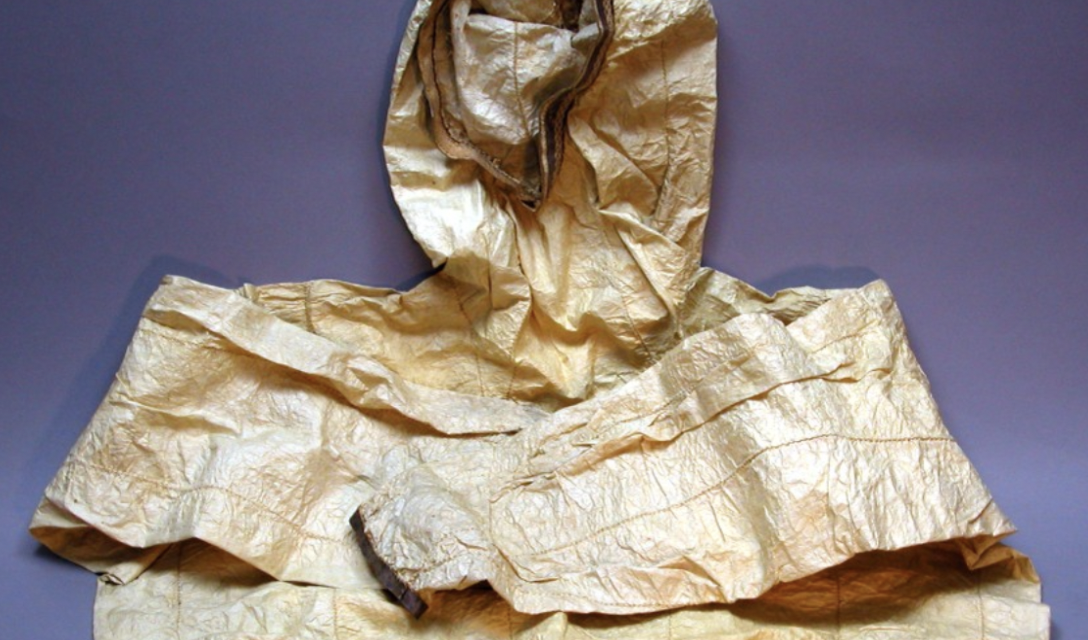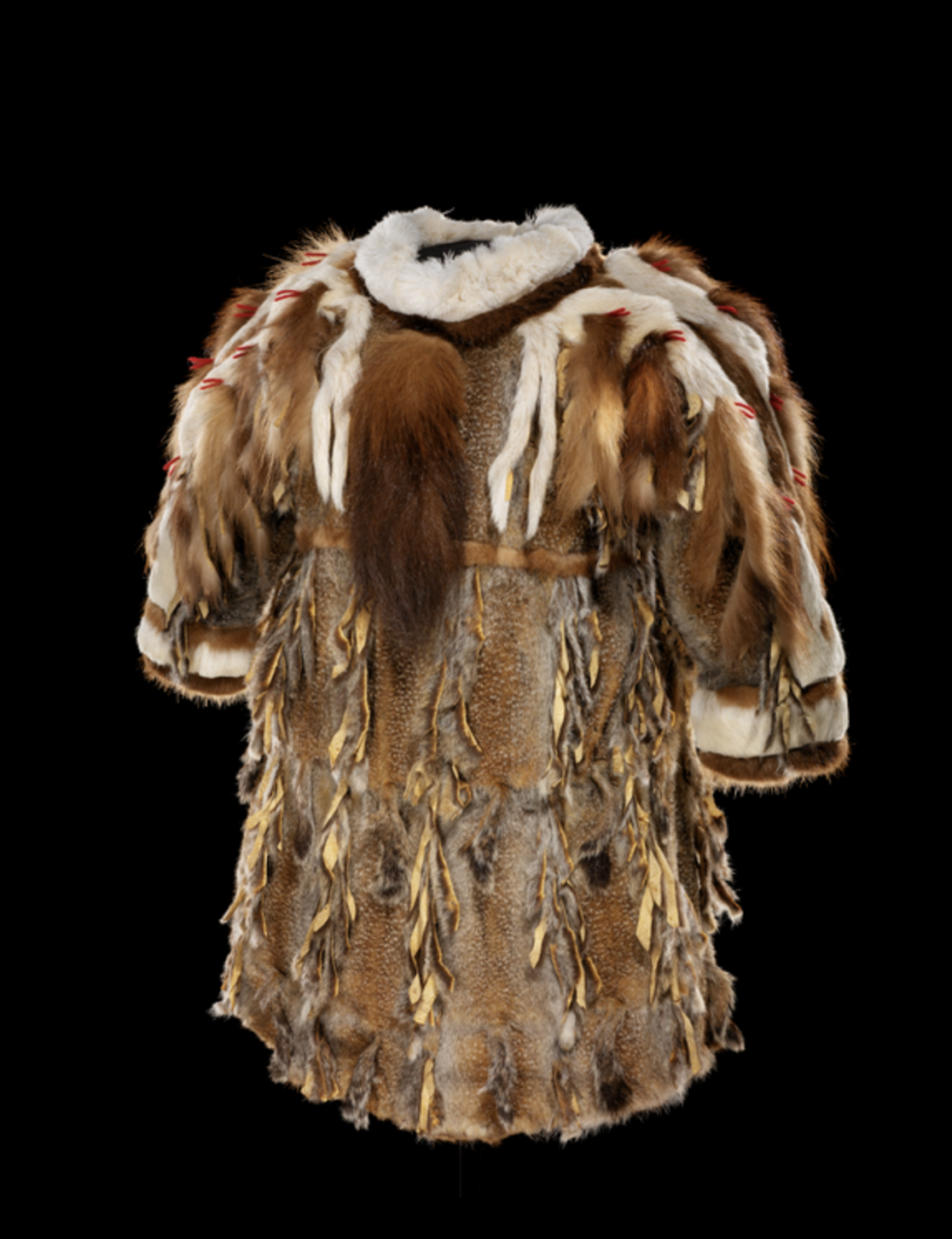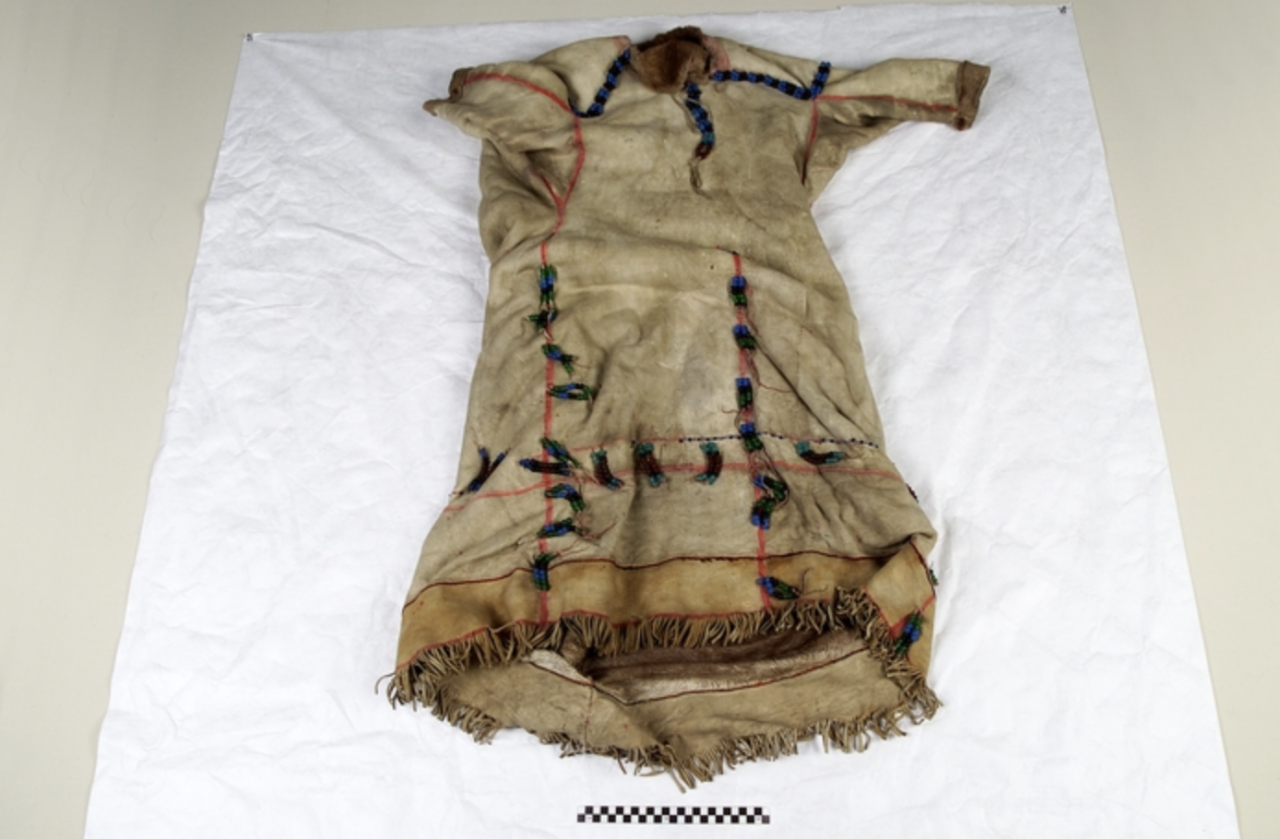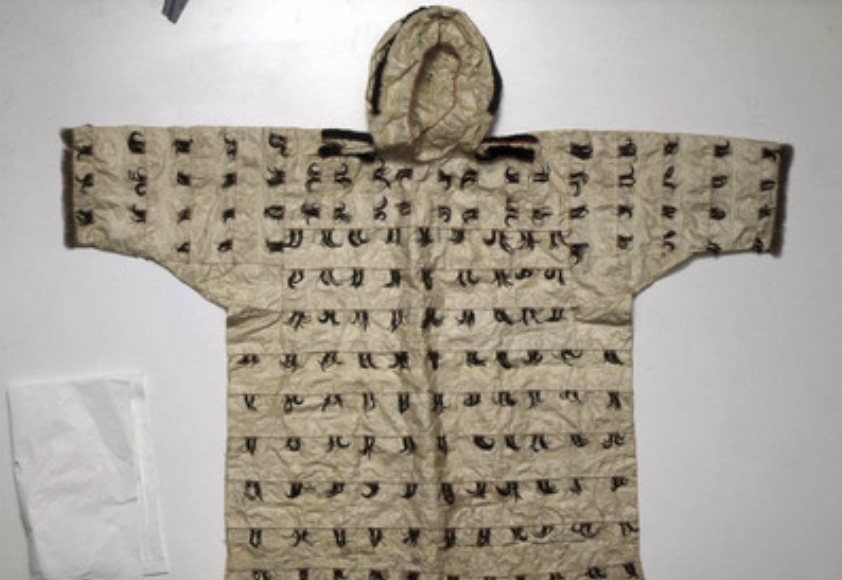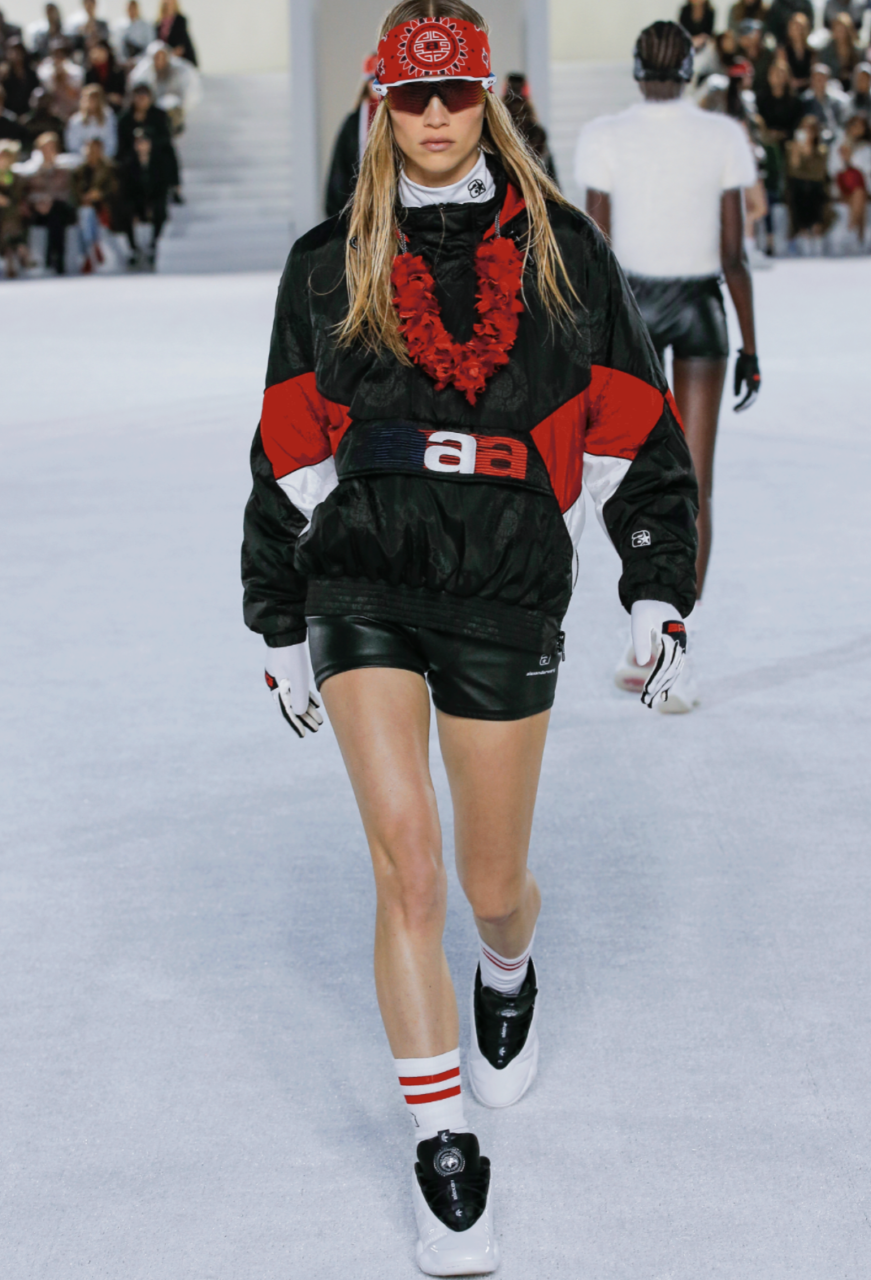An anorak is a jacket that typically has a hood, but not always, which was originally worn by the indigenous peoples of the Arctic designed to keep them warm and protected from harsh weather.
The Details
C unera Buijs notes in the Berg Encyclopedia of World Dress and Fashion (2010) that the anorak jacket came in many different variations and styles for each member of the family:
“Married young women dressed in white skin or cotton anoraks with tails, reminiscent of the caribou-fur coats and decorated with beads. These hoodless jackets were decorated around the neck with a small band of beads arranged in a geometrical pattern.”
This anorak (Fig. 1) for a young boy was created circa 1915 by a Kuskokwim maker of Alaska and is made and ornamented with a variety of animal hides and furs. Squirrel, caribou, muskrat, and wolverine skin and fur, along with wool are used to create this jacket.
In the Encyclopedia of Clothing and Fashion (2005), Tom Greatrex states that the anorak was designed for the upper part of the body to give protection from the wind:
“In one version, the Inuit parka was made of two animal skins (either seal or caribou) sandwiched together, with the skin side of each facing outward and the hair side facing inward to trap warm air and retain it for insulation purposes. Although it was not a rain garment as such, it was generally waterproofed, using seal gut until other methods were introduced during the nineteenth century.”
As seen in (Fig. 2) this anorak jacket is located at the Peabody Museum of Archaeology and Ethnology. It was found in Western Greenland and originated between 1900-1910. It is made with seal intestine sewn together with reindeer or caribou sinew.
Daniel Delis Hill writes in The History of World Costume and Fashion (2011) that the indigenous peoples of the Arctic and Subarctic developed the anorak jacket:
“The major outerwear garment was a hooded coat, or parka, called an anorak, that layered over the tunic. The hood was edged with a long-haired fur, such as that of a wolverine, so ice crystals that formed from breathing could be brushed off easily. Decorative motifs included a pair of triangular appliques of contrasting white fur at the neckline of men’s anoraks to represent walrus tusks.” (303)
An anorak in the National Museum of the American Indian (Fig. 3) is hand-painted and trimmed with beads, in addition to the use of caribou hide and skin to construct it. The Gwich’in group found in the Yukon Territory of Canada created this particular anorak.
In the Encyclopedia of American Indian Costume (1994), Josephine Paterek informs readers that anoraks were created with hide or sealskin depending on the weather or season:
“The ‘parka’ (a Russian term), called anorak in the central Arctic and Greenland, was the major garment of the Eskimo; it was put on over the head, was generally hooded, and had tails in front and back of varying lengths, longer in back for sitting on ice. It was usually of caribou hide (for winter) or sealskin (summer). The length was to the hips or the knees, depending on the locality. A large ruff of wolverine or wolf hair around the face helped shed the ice crystals formed from breathing.” (385)
Figure 4 is a seal intestine anorak worn by the Inuit group of the Arctic, but is now in the collection of the American Museum of Natural History.
Fig. 1 - Artist unknown (Kuskokwim). Boy's parka, circa 1915. Squirrel skin/fur (ground squirrel), caribou hide/skin, muskrat skin/fur, wolverine skin/fur, wool yarn, sinew; 90 x 120 cm. Washington, D.C.: National Museum of the American Indian, 11/6723. Collected by Bethel, Alaska, trader Adams Hollis Twitchell (1872-1949), probably between 1905 and 1916; purchased by MAI from A. H. Twitchell in 1923. Source: NMAI
Fig. 2 - Artist unknown (West Greenland). Hooded anorak of seal intestine; sewn with reindeer or caribou sinew; banding ar, 1900-1910. Intestine; hide; 82 x 135 cm. Cambridge, MA: Peabody Museum of Archaeology and Ethnology, 970-26-10/51078. Source: JSTOR
Fig. 3 - Artist unknown (Gwich'in). Parka, Collected in 1917. Caribou hide/skin, glass bead/beads; 140 x 100 cm. Washington, D.C.: National Museum of the American Indian, 7/1049. Collected in 1917 by Donald A. Cadzow (1894-1960, MAI staff member) during MAI-sponsored fieldwork.. Source: NMAI
Fig. 4 - Artist unknown (Inuit). Anorak, 1995. New York: American Museum of Natural History, 60.2/5500. Source: American Museum of Natural History
Its Afterlife
The anorak jacket is still being worn today as a form of protection from weather; now it is often being made with synthetic, dry-wicking materials rather than animal furs. Like earlier anorak designs, anoraks today are styled as fashion outer-garments by their varying lengths, materials, and colors. This jacket has been spotted on designer runways of Valentino and Alexander Wang within the last couple of years. Additionally, anoraks are sold at numerous global retail brands, such as Lululemon, Banana Republic, and L.L. Bean.
Fig. 5 - Valentino. Is the Rain Anorak the New Leather Jacket?, 2017. Source: Vogue
Fig. 6 - Alexander Wang. The Styling Essential: An Anorak, 2019. Source: Net-a-Porter
References:
- Bell, Alice. “Is the Rain Anorak the New Leather Jacket?” Vogue, October 10, 2017. https://www.vogue.com/article/anorak-athleisure-spring-2018-trends.
- Buijs, Cunera. “Greenland.” In Berg Encyclopedia of World Dress and Fashion: West Europe, edited by Lise Skov, 363–368. Oxford: Berg, 2010. Accessed October 11, 2021. http://dx.doi.org.libproxy.fitsuny.edu/10.2752/BEWDF/EDch8060.
- Greatrex, Tom. “Windbreaker.” In Encyclopedia of Clothing and Fashion, edited by Valerie Steele, 433-434. Vol. 3. Detroit, MI: Charles Scribner’s Sons, 2005. Gale eBooks (accessed October 11, 2021). https://link.gale.com/apps/doc/CX3427500642/GVRL?u=fitsuny&sid=bookmark-GVRL&xid=59c84bd8.
- Hill, Daniel Delis. History of World Costume and Fashion. Upper Saddle River, NJ: Pearson Prentice Hall, 2011. http://www.worldcat.org/oclc/768100950.
- Logue, Megan. “The Styling Essential: An Anorak.” Net-A-Porter, January 9, 2019. https://www.net-a-porter.com/en-gb/porter/article-8e458fb6546cb4ec/fashion/fashion-memo/best-designer-anorak.
- Paterek, Josephine. Encyclopedia of American Indian Costume. Denver, Colo: ABC-CLIO, 1994. http://www.worldcat.org/oclc/805700716

